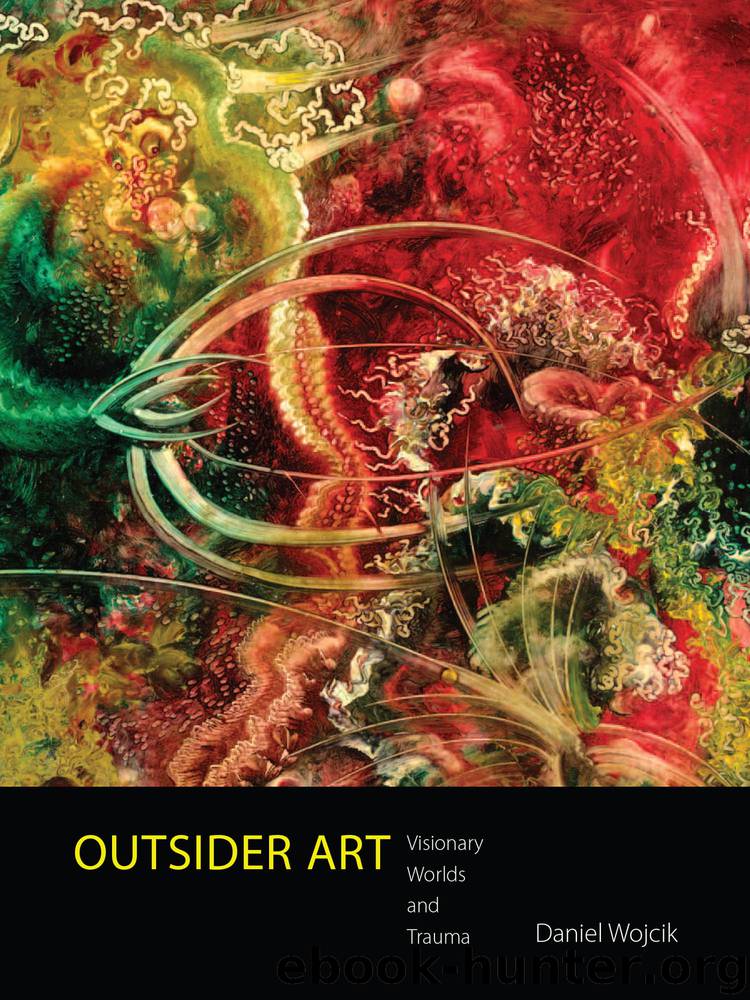Outsider Art by Daniel Wojcik

Author:Daniel Wojcik
Language: eng
Format: epub
Publisher: University Press of Mississippi
Published: 2016-12-09T16:00:00+00:00
Sabato Rodia and the Watts Towers
For decades, similar assumptions have been applied to the internationally known Watts Towers, an art environment created by Sam (Simon) Rodia in South Central Los Angeles. Rodia (1879–1965), born Sabato Rodia in the village of Rivottoli Serino, east of Naples, Italy, created a complex of seventeen structures, including three spectacular and ornate spires. The tallest, measuring ninety-nine and a half feet in height, is made of interwoven steel rods wrapped with wire mesh, then covered in cement and decorated with a colorful mosaic of found objects, including glass, porcelain, ceramic tiles, and sea shells. A scalloped wall covered with mosaic surrounds the environment. Inside, in addition to the three large towers, are four smaller towers, a gazebo, fountains, birdbaths, benches, walkways, gardens, and a boat covered in mosiac. Rodia’s towers are considered to be the largest structures ever made by a single human being working alone. As an essential part of the vernacular architectural landscape of Los Angeles, his towers have inspired individuals ranging from Ed Kienholz and Betye Saar to Niki de Saint Phalle, Don DeLillo, and Charles Mingus (who lived a block away from the towers and watched Rodia construct them with admiration).3 Buckminster Fuller was another admirer, who claimed that Rodia was “one of the greatest sculptors of the twentieth century,” an intuitive genius with an innate understanding of design and the principles of engineering (Goldstone and Goldstone, 1997: 3–5, 39, 50; Landler and Byer, 2006).
Like the postman Cheval, Rodia worked alone on his structures, apparently every day for thirty-three years, using sophisticated techniques of construction involving mortar, mesh, inlaid objects, and plenty of steel. He also was a master of bricolage, like Cheval, creatively harnessing whatever materials were at hand. Rodia, Cheval, Hampton, Finster, Chand, and other builders of art environments such as Raymond Isidore, Helen Martins, and Tressa Prisbrey embody the concept of the bricoleur as a do-it-yourself inventor, a resourceful jack-of-all trades creating with scrap, leftovers, and odds and ends. When discussing the ways that mythologies are constructed, anthropologist Claude Lévi-Strauss specifically refers to Cheval and his Palais as an illustration of the concept of bricolage, the process by which an individual creator with limited resources uses available materials in new ways and creates things from miscellaneous objects salvaged from a variety of sources (1966: 18–19). Rodia drew upon the materials that were available to him too—broken pottery, tiles, glass, shells—and skillfully reused these cast-off objects in inventive ways, giving them new meanings in his stunning sculptural displays.
Download
This site does not store any files on its server. We only index and link to content provided by other sites. Please contact the content providers to delete copyright contents if any and email us, we'll remove relevant links or contents immediately.
Big Magic: Creative Living Beyond Fear by Elizabeth Gilbert(5609)
Paper Towns by Green John(5086)
On Writing A Memoir of the Craft by Stephen King(4862)
The Doodle Revolution by Sunni Brown(4683)
Hyperfocus by Chris Bailey(4042)
Evolve Your Brain by Joe Dispenza(3608)
Unlabel: Selling You Without Selling Out by Marc Ecko(3586)
The Red Files by Lee Winter(3366)
Draw Your Day by Samantha Dion Baker(3285)
The Power of Mindful Learning by Ellen J. Langer(3184)
The Art of Dramatic Writing: Its Basis in the Creative Interpretation of Human Motives by Egri Lajos(3013)
The War Of Art by Steven Pressfield(2867)
Applied Empathy by Michael Ventura(2836)
The 46 Rules of Genius: An Innovator's Guide to Creativity (Voices That Matter) by Marty Neumeier(2796)
How to be More Interesting by Edward De Bono(2742)
Why I Am Not a Feminist by Jessa Crispin(2695)
Keep Going by Austin Kleon(2695)
How to Stop Worrying and Start Living by Dale Carnegie(2645)
You Are Not So Smart by David McRaney(2593)
